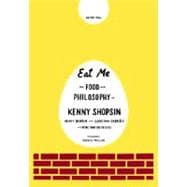
Note: Supplemental materials are not guaranteed with Rental or Used book purchases.
Purchase Benefits
What is included with this book?
Kenny Shopsin is a self-taught chef who has developed his own inimitable style: he colors outside of the lines and then uses the crayons in his pancakes. He lives in Greenwich Village.
Carolynn Carreño is a James Beard Award–winning journalist and the coauthor of 100 Ways to Be Pasta, Once Upon a Tart, and A Twist of the Wrist. She lives in Los Angeles and New York.
The New copy of this book will include any supplemental materials advertised. Please check the title of the book to determine if it should include any access cards, study guides, lab manuals, CDs, etc.
The Used, Rental and eBook copies of this book are not guaranteed to include any supplemental materials. Typically, only the book itself is included. This is true even if the title states it includes any access cards, study guides, lab manuals, CDs, etc.
Excerpted from Eat Me: The Food and Philosophy of Kenny Shopsin by Kenny Shopsin, Carolynn Carreño
All rights reserved by the original copyright owners. Excerpts are provided for display purposes only and may not be reproduced, reprinted or distributed without the written permission of the publisher.